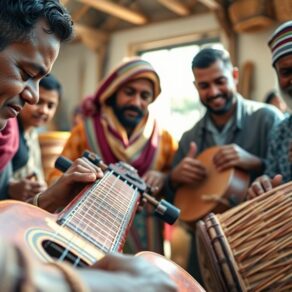You'll find that five ancient cultures greatly embraced wind instruments, each reflecting their unique societal values. The Egyptians used flutes in rituals, while the Chinese celebrated their bamboo flutes in weddings and spiritual ceremonies. Native Americans relied on wooden flutes for healing and storytelling, fostering deep emotional connections. The Greeks incorporated the aulos into theater and religious events, and Celtic cultures celebrated with instruments like bagpipes, intertwined with community traditions. These cultures utilized wind instruments not just for sound, but as essential expressions of identity and unity. You'll uncover even more fascinating details about these rich musical heritages.
Key Takeaways
- Ancient Egyptians utilized flutes made from wood and clay in rituals, enhancing communal experiences and spiritual practices.
- Chinese culture embraced bamboo flutes, symbolizing cultural identity and used in weddings and spiritual ceremonies.
- Native American tribes crafted flutes from wood and bone, integral to healing rituals and storytelling, expressing deep emotions.
- Ancient Greeks played the aulos in theatrical performances and religious ceremonies, making it essential to their cultural expressions.
- Celtic societies employed various wind instruments, like bagpipes, for storytelling and celebrations, fostering community and preserving their rich musical heritage.
Ancient Egyptians and Their Flutes

The ancient Egyptians crafted flutes that weren't just musical instruments but integral components of their cultural and spiritual life. When you investigate flute construction during this era, you discover an impressive blend of artistry and functionality. Made from materials like wood, reed, and even clay, these flutes varied in size and design, reflecting the socio-cultural nuances of the time. Each piece was meticulously fashioned, often adorned with intricate carvings that told stories of gods, nature, and daily life.
Flutes played a significant role in musical rituals, serving as a conduit between the earthly domain and the divine. You'll find that these rituals often accompanied religious ceremonies, festivals, and funerary practices, reinforcing community bonds and shared beliefs. The sound of the flute, with its enchanting melodies, was believed to invoke the presence of deities and facilitate communication with the spiritual world. Additionally, the Western Concert Flute emerged as a prominent instrument in later musical traditions, showcasing the enduring legacy of wind instruments.
As you explore this aspect of ancient Egyptian life, consider how music, particularly through the flute, fostered a sense of belonging among the people. It wasn't merely about entertainment; it was about connecting with one another and the cosmos.
Whether played during celebrations or solemn occasions, the flute's music transcended the mundane, inviting participants into a shared experience of reverence and joy. Fundamentally, the flute was a vibrant thread woven into the rich tapestry of ancient Egyptian culture, embodying their values, beliefs, and communal identity.
Chinese Traditions of Wind Instruments

Exploring the rich tapestry of Chinese traditions reveals a profound appreciation for wind instruments, which have played a pivotal role in the country's musical heritage for centuries. Among these instruments, bamboo flutes hold a special place, known for their sweet, resonant tones that evoke a deep emotional connection. These flutes, often crafted by skilled artisans, aren't just instruments; they symbolize cultural identity and continuity.
In traditional Chinese music, bamboo flutes are frequently used in a variety of contexts, particularly in ceremonial music. Whether it's a wedding, a harvest festival, or a spiritual rite, the haunting melodies of the flute enhance the atmosphere, creating a sense of unity and shared experience. You might find yourself captivated by how the flutist's breath transforms simple bamboo into an instrument of storytelling, weaving narratives of love, loss, and joy.
Moreover, the role of wind instruments extends beyond mere entertainment. They serve as a bridge between the human experience and the spiritual dimension. In rituals, the sounds of bamboo flutes are believed to connect participants with their ancestors, inviting their presence and wisdom. This belief fosters a profound sense of belonging within communities, as the music becomes a shared language that transcends generations.
As you explore the world of Chinese wind instruments, you'll uncover not just the technical mastery involved in playing the bamboo flute but also the emotional and cultural resonance these traditions hold. The craftsmanship of these instruments, such as the Wooden Flute Piccolo, adds to their unique charm and durability.
Indigenous American Flute Practices

Among the diverse musical expressions of Indigenous American cultures, flute practices stand out for their deep spiritual significance and cultural heritage. The Native American flute, often crafted from wood or bone, serves not only as a musical instrument but also as a conduit for expressing emotions, storytelling, and connecting with the spiritual world.
When you explore these flute ceremonies, you'll discover their role in various aspects of life, including healing rituals, celebrations, and personal introspection.
Here are three key elements of Indigenous American flute practices:
- Sacred Connection: The flute is often viewed as a voice of the spirit, bringing forth messages from nature and ancestors. During ceremonies, its melodies create a sacred atmosphere that fosters connection and reflection.
- Cultural Transmission: Flute music is passed down through generations, preserving stories, traditions, and values. Learning to play the flute isn't just about music; it's about understanding one's identity and cultural roots.
- Healing Properties: Many Native American communities believe in the therapeutic qualities of flute music. It's often used in healing ceremonies to promote well-being, ease suffering, and enhance emotional balance. The use of wind instruments, such as flutes, reflects the broader cultural significance of these instruments in diverse musical traditions worldwide.
Greek Contributions to Wind Music

While examining the vast landscape of wind instruments, Greek contributions reveal a rich tapestry of innovation and cultural significance. The Greek aulos, a double-reeded wind instrument, stands out as a quintessential element of their musical heritage. Often made from materials like wood or bone, this instrument produced a distinctive sound that resonated throughout ancient Greek festivities, from theatrical performances to religious ceremonies.
When you think about the aulos, consider how it wasn't merely an instrument; it served as a vessel for storytelling and communal experience, echoing the emotions of the people.
In tandem with the aulos, the ancient lyre played a pivotal role in Greek music, symbolizing harmony and poetic expression. Musicians often paired the lyre with the aulos during performances, creating a dynamic interplay between string and wind. This combination enriched the sonic landscape, allowing for deeper emotional connections among listeners.
You can imagine how gatherings would come alive with the resonance of these instruments, fostering a sense of belonging and unity.
Moreover, Greek philosophers and theorists, like Pythagoras, explored the mathematical relationships in music, emphasizing how wind instruments like the aulos embodied these principles. This intellectual curiosity not only advanced musical theory but also highlighted the cultural importance of wind music in Greek society. The legacy of wind instruments, such as the concert flute, showcases the enduring impact of ancient practices on modern musical traditions.
As you investigate this era, it's clear that the Greeks' contributions to wind instruments were profound, shaping the musical traditions that continue to inspire us today.
Celtic Cultures and Their Wind Instruments

Celtic cultures offer a fascinating array of wind instruments that reflect their rich musical heritage and communal traditions.
These instruments not only produce beautiful sounds but also serve as essential tools for storytelling and celebration, fostering a sense of belonging among communities.
You'll find that the most iconic wind instruments in Celtic music include:
- Celtic Bagpipes: Known for their emotive melodies, these instruments have a deep connection to Scottish and Irish identities. The unique drone sound of bagpipes resonates during festive gatherings, instilling pride and unity among those who play and listen.
- Irish Whistle: This simple yet enchanting instrument has a history that dates back centuries. The Irish whistle's melodious tones are often heard in folk songs, creating an inviting atmosphere that encourages collective participation and shared experience.
- Uilleann Pipes: A more intricate version of bagpipes, Uilleann pipes are distinctively Irish. Their sweet, reedy sound captures the essence of traditional Irish music, bringing people together through lively jigs and heartfelt ballads.
When you immerse yourself in the world of Celtic wind instruments, you're not just listening to music; you're connecting with a vibrant cultural tapestry woven through generations. Additionally, these instruments, such as the Irish whistle, are celebrated for their versatility across various musical genres beyond traditional Irish music.
Each note played on a Celtic bagpipe or an Irish whistle echoes the stories and emotions of those who came before you, inviting you to partake in a rich tradition that celebrates community and belonging.
Frequently Asked Questions
What Materials Were Used to Make Ancient Wind Instruments?
When you explore ancient wind instruments, you'll find that artisans primarily sourced materials from their surroundings.
Wood, bone, and reeds were popular for crafting these instruments, given their availability and acoustic properties. Some cultures even used metals like bronze or silver for durability and resonance.
The instrument crafting process involved meticulous attention to detail, ensuring each piece produced a unique sound that resonated with the community, fostering a sense of belonging through music.
How Were Wind Instruments Played in Ancient Rituals?
When you engage with wind instruments in ancient rituals, you'll notice their profound ritual significance.
These melodic marvels filled ceremonial contexts, enhancing the atmosphere of sacred events. Musicians skillfully played flutes and horns, creating enchanting sounds that resonated with spiritual energy.
Each note echoed the community's beliefs, fostering a sense of belonging among participants. By embracing these instruments, you experience the deep connection between music, tradition, and the collective spirit of the culture.
Did Ancient Cultures Have Formal Music Education for Wind Instruments?
Did ancient cultures have formal music education for wind instruments?
While not formalized like today's music pedagogy, many societies prioritized cultural transmission through mentorship and communal learning.
You'd often find experienced musicians guiding novices, sharing techniques and traditions. This oral transmission fostered a sense of belonging, as you'd connect with your community through shared musical practices.
The emphasis on collective participation in music helped guarantee that knowledge and skills were passed down through generations.
How Did Trade Influence the Development of Wind Instruments?
Imagine a bustling marketplace, where musicians from different regions share melodies.
Trade facilitated cultural exchange, allowing diverse styles and techniques to mingle, sparking musical innovation.
As merchants transported goods, they carried wind instruments, introducing new materials and construction methods.
You can see how these interactions enriched local traditions, creating unique sounds that reflected a blend of influences.
This interconnectedness forged a deeper appreciation for music, illustrating how trade shaped the evolution of wind instruments.
What Role Did Wind Instruments Play in Ancient Storytelling?
Wind instruments played an essential role in ancient storytelling, serving as a vibrant medium for mythical narratives and cultural expression.
You'd find that these instruments often accompanied tales, enhancing the emotional depth and atmosphere of performances. As storytellers wove intricate plots, the sounds from flutes and horns would evoke feelings of joy, sorrow, or suspense, making the stories more immersive.
Through these connections, communities fostered a shared sense of identity and belonging.
Conclusion
In exploring these ancient cultures, it's clear that wind instruments played a vital role in their musical landscapes. From the haunting melodies of Egyptian flutes to the rich traditions of Indigenous American music, each society found a unique voice through breath and sound. Isn't it fascinating how these instruments not only shaped their cultures but also connected people across time and space? Understanding this legacy deepens our appreciation for the universal language of music that continues to resonate today.






